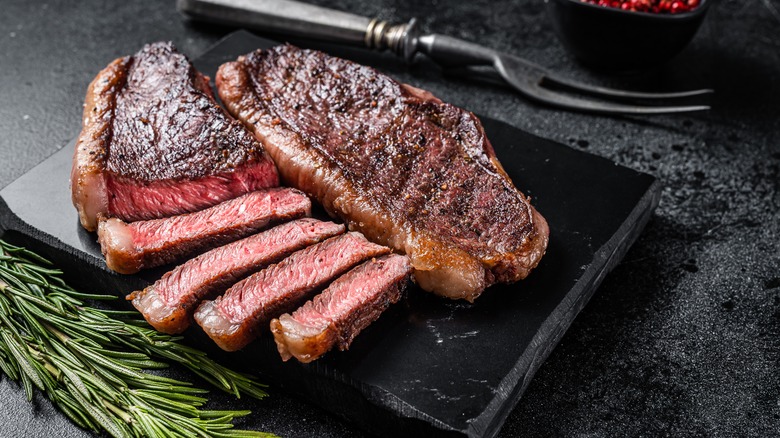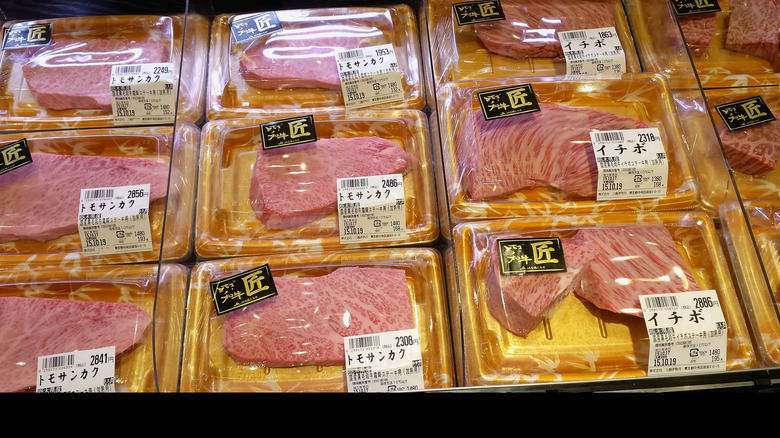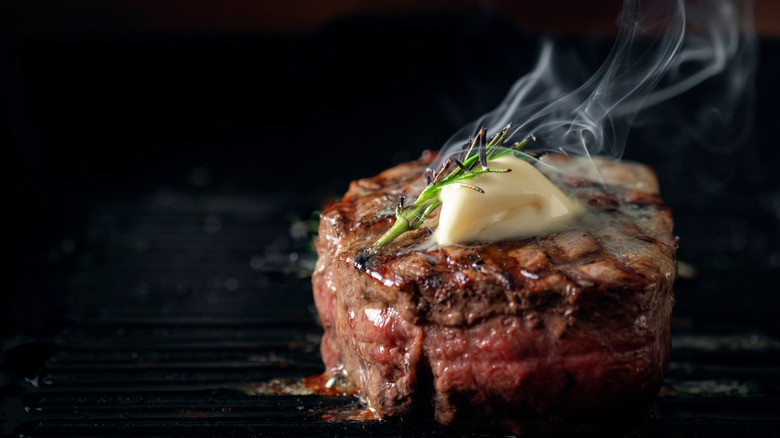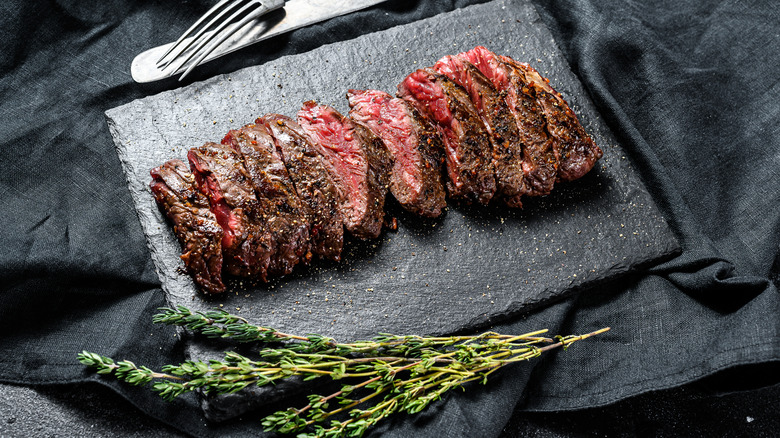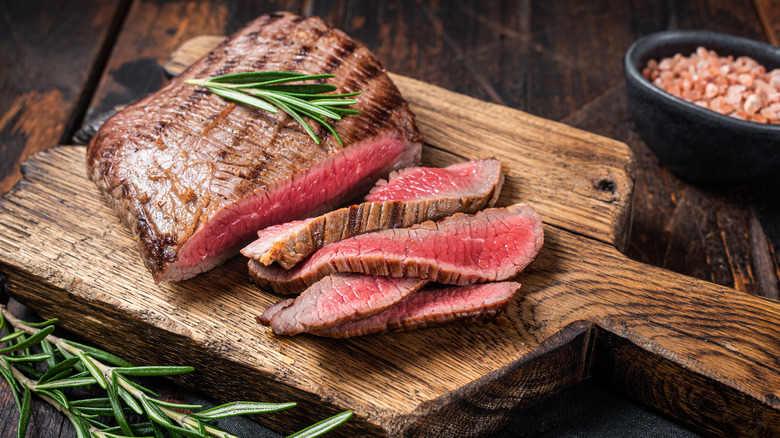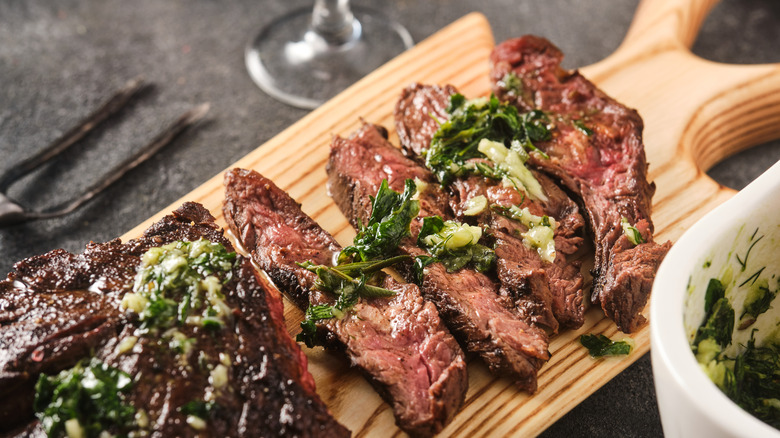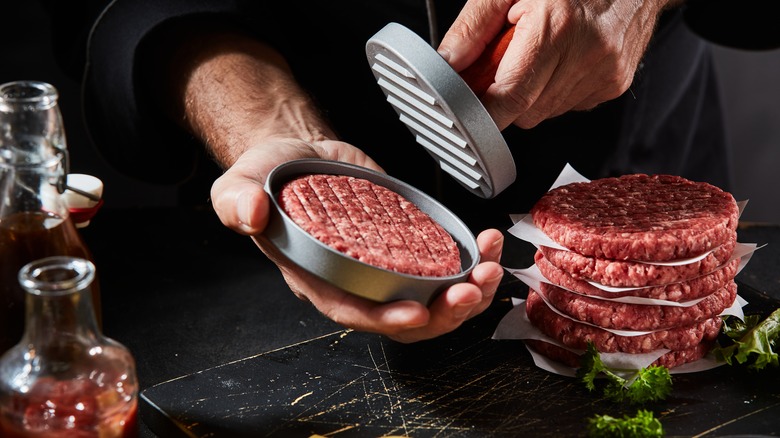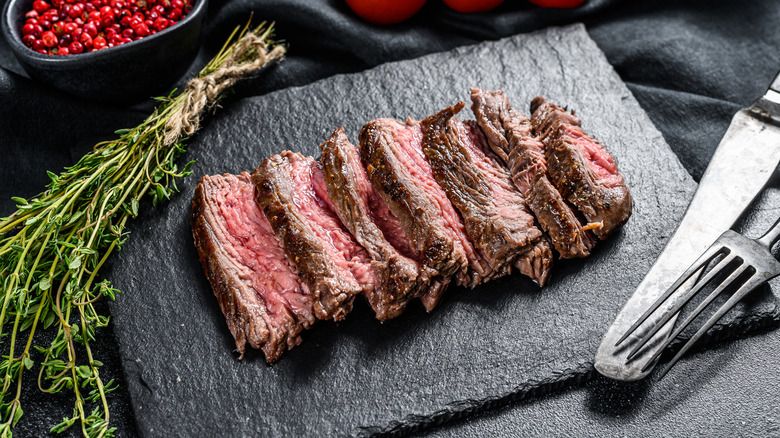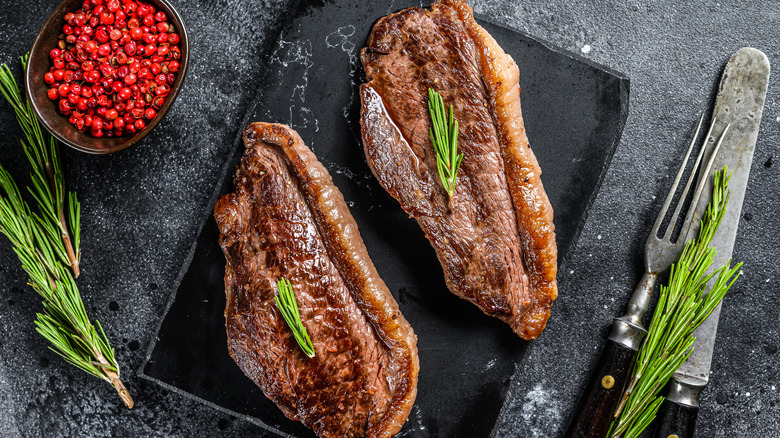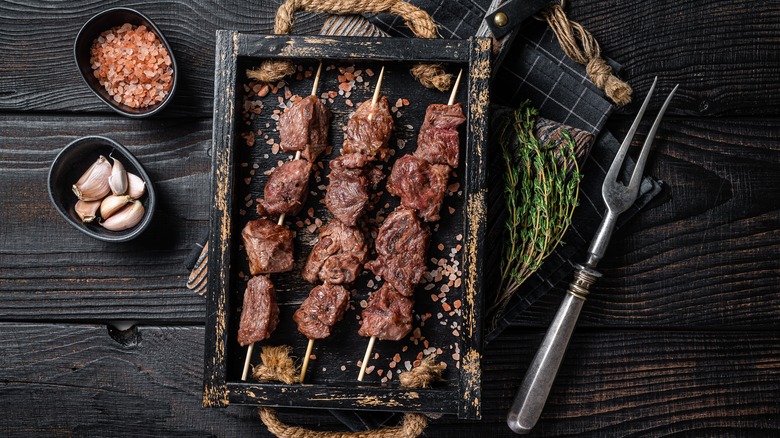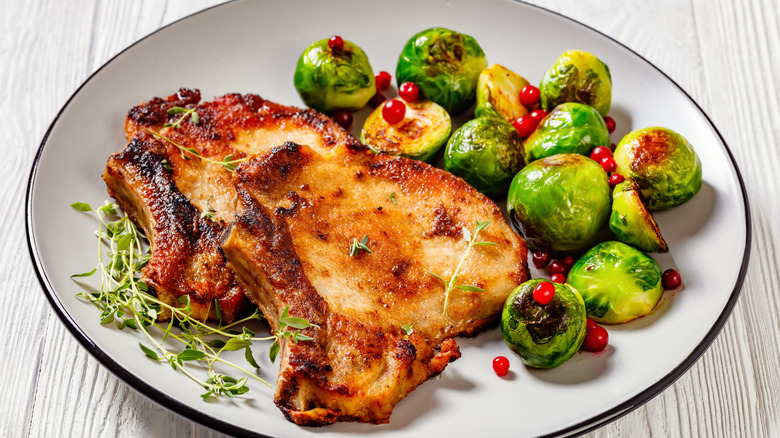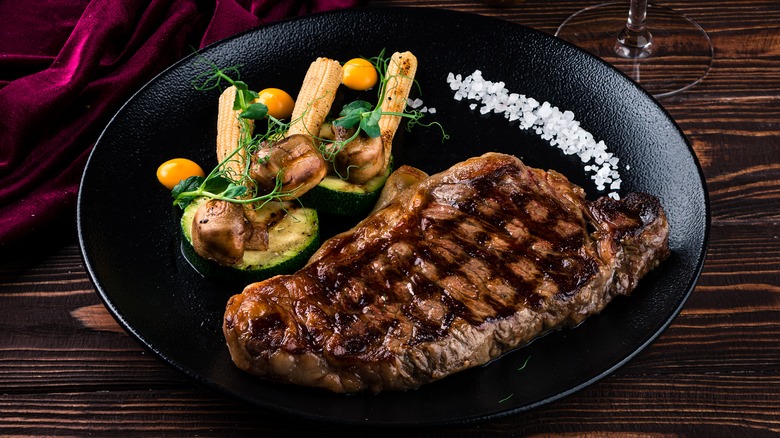Cuts Of Steaks Chefs Won't Even Eat
A cow is an enormous animal, and it can yield incredible amounts of meat. Per the Institute of Agriculture and Natural Resources at the University of Nebraska-Lincoln, a consumer can expect about 570 pounds of meat from a 1,400-pound cow once processed. Now that's a lot of beef.
And there are myriad ways to use that meat. It can be ground, chopped, shaven, and more, but one of the finest ways to use beef is by turning it into steak. Steak is an incredibly popular cut of meat in the United States. In fact, per Meats by Linz, 64% of Americans would include steak in their "last meal" if given the choice.
Steak is as expensive as it is popular. Per the U.S. Bureau of Labor Statistics via the Federal Reserve Bank of St. Louis, at its highest point in 2021, the average price of a USDA choice boneless sirloin steak was over $11 per pound. By comparison, per the Federal Reserve Bank data, the highest average price of chicken in 2021 was less than $2 per pound.
Despite these prices, Americans still eat steak, and everyone has an opinion on which cut of steak is the best. There are some cuts, though, that some wouldn't deign to dine on, and we got the scoop straight from the people who cook our steaks. Here are the cuts of steak chefs won't even eat.
Anything prepackaged
Food Network Chef Bobby Flay is a master of grilling, and with that skill comes an intimate knowledge of which steaks are the best and which you should avoid. For Flay, it's less about the cut of the meat and more about the source. As he told Food Network, it's best to purchase meat at a meat counter rather than something packaged in a store. "Buy from a good butcher shop or from the butcher at your supermarket's meat counter. Avoid prepackaged steaks — plastic wrap traps in moisture." Flay has a point, particularly if you're about to put your meat on the grill. Per CNN, meat should go on the grill dry, not wet. Moisture is the enemy of texture.
Avoiding plastic wrap and prepackaged steak aren't Flay's only tips. When it comes to meat, Flay says, "Spring for USDA Prime or Certified Black Angus steaks if you can. Choice-grade steak is a good, less-expensive alternative." He's also particular about marbling. "Thin white streaks of fat throughout a steak, called marbling, keep the meat nice and juicy. Plus, the fat adds flavor."
Flay is right about marbling, too. Per MasterClass, marbling allows the steak to maintain moisture, which helps retain its natural juices. It's also more tender than muscle, so you'll have a better texture thanks to marbling.
Filet mignon
Here's one that may come as a shock to you. Although filet mignon is highly regarded by some as one of the best cuts of steak, there are lots of chefs who find it overrated, and even inedible. One of the most famous chefs to hold this opinion is the late Anthony Bourdain. As the chef told Insider, tenderloin, which is the cut of the cow that filet mignon comes from, is "the most boring and uninteresting piece of meat on the animal."
There are plenty of other chefs who share Bourdain's opinion. As Christopher Arturo, culinary arts chef-instructor at the Institute of Culinary Education in New York, told Mashed, "This cut just doesn't have the marbling or structure that I like in a steak. To me, it [is] always too supple and lacking in beefy flavor. Not to say I haven't had my fair share of excellently marbled, amazingly tasty filet, but those to me are the exception to the rule."
Steve Ozbolt of Emerald City Catering and Events in Milwaukee, Wisconsin, echoed those thoughts. "There is virtually no fat, therefore no flavor. If I wanted a large piece of unmarbled meat, I would buy a sirloin steak for about half the price. The best, however, is a ribeye. Beautiful marbling and tender, it lends itself to be grilled or pan-seared in herb butter," he told us.
Skirt steak
Skirt steak comes from the plate of the cow, the middle region that runs along the bottom. Per The Spruce Eats, skirt steak has a thick grain and a very beefy flavor. Skirt steak is quite often used in fajitas and carne asada tacos, and you've probably seen it served in slices rather than as a filet.
Lots of people are fans of skirt steak, but some chefs aren't quite so taken with it, like Yester Banuchyan, chef, CEO, and founder of Cook On Monday food blog. Banuchyan told Mashed, "I find skirt steak the most troubling cut. The meat itself is tough, but preparing it doesn't get easy either. Being difficult to cook or requiring finesse is one thing, but the skirt steak borders on being unwieldy, and it takes a fair amount of effort just to get it to cook!"
Chef Banuchyan suggests another cut instead. "I think the T-bone steak hits all the right notes on texture and cooking," she said. "There's plenty of meat, fat, and flavor in this single cut. It's also visually stunning on the plate. It is the full package — the T-bone is food for the eyes, the aroma is great, the texture feels wonderful in the mouth, and, of course, it's very filling and enjoyable to eat."
London broil
Another cut of steak some chefs don't like to eat? The London broil. If you're unfamiliar with this cut, it's because, per The Spruce Eats, it's not a true cut of steak. It's actually the way the meat is cooked, and the name has become conflated as the cut.
As Gabriel Glasier, former executive chef, restaurateur, and founder of the blog Chef Travel Guide, explained to Mashed, "The London Broil was originally a repurposed flank steak, but now it is whatever chewy cut of beef that the butcher can't sell under its real name." He continued, "There is nothing worse than a London Broil. This cut offers a tough and chewy texture that is completely devoid of any marbling ... It's common to end up with a portion of the bottom round that must be marinated, perfectly cooked, and sliced properly, even to be edible. This beef cut caused kids nightmares of having to stay at the table to finish their food because the steak was nearly impossible to chew."
Glasier, whose favorite cut is a hanger steak, also gave some advice for choosing steak. "It's a good idea to be a little skeptical if you see a steak cut with a name that you haven't ever seen before," he said. "If you see a baseball steak or an oyster steak on a menu or in a meat case at the grocery store, skip it and order a cut that you know will be delicious and tender."
Hanger steak
While some chefs love hanger steak, there are butchers who would prefer customers not buy it. Massachusetts butcher Terry Ragasa shared his thoughts with Huff Post. "Out of an 800-pound animal there is a pound and a half of hanger steak. It's delicious because it doesn't do any work; it literally hangs next to the kidneys," he said. As The Spruce Eats points out, hanger steak was originally called "butcher's steak" because butchers, recognizing its quality and flavor, kept it instead of selling it, and most general customers didn't know it was available. So if butchers historically have loved hanger steak, why do some, like Ragasa, now campaign against it?
According to Ragasa, eating hanger steak isn't sustainable. "If 10 people order a hanger steak at a restaurant, that represents 10 animals slaughtered for those dinners," he said. "I think waste-conscious consumers should consider eating more cuts from the chuck, as it makes up nearly a third of the total meat available from a single head of beef." To eat steak more sustainably, Ragasa suggests eating Denver or Ranch cuts. As he noted, Ranch in particular is "a leaner cut that's very similar to a top sirloin, and has the tenderness of a sirloin with the flavor of a work muscle."
Eating steak sustainably will require more than just ordering particular cuts. As The Nature Conservancy details, sustainability practices within the beef industry need to comprise the entire system.
Round steak
An inexpensive cut of steak is a round steak. Although inexpensive doesn't necessarily equal poor quality, in this case, according to James Watts, CEO of the online resource Own The Grill, it does. Watts shared with Mashed his opinion on steak cuts and noted that round steak is the worst "because it's all muscle and not fat, which means there's very little fat and almost zero marbling to add flavor, and it takes far longer to cook. And judging the timing is far more complex, as there's a finite window between grilling a pretty good round steak, and overcooking and burning it." Isabella Flint, the chef, CEO, and founder of Fanatically Food, said she is not a fan of round steak either. "There is little fat running through the steak, giving it a tough texture and taking away from the flavor," she told Mashed.
Round steak does have a place, though. If you're abstaining from using it for steak, you can use it as ground beef, jerky, deli meat, and more, as noted by The Prairie Homestead.
And what does Watts prefer for steak? "It has to be a ribeye, as it's full of marbled fat and flavor, takes next to no time to cook well, and only needs a dash of seasoning to be cooked to perfection and become melt-in-your-mouth delicious," Watts said. "Life is far too short for bad steak, so spend a little extra and get the best cut that you can. You're worth it."
Flank steak
Flank steak is another lean cut of beef. It comes from a cow's abdominal area near the area where skirt steaks are found, and it's similar in texture and taste. Per Beef Checkoff, flank steak is often used in stir fries, and it can easily be broiled thanks to its thinness. For some, like retired cook and food blogger Kenzo Kishita, flank steak isn't worth the trouble. "It's a pretty lean cut, and it's got a lot of connective tissue and fat around it. It's also an easy cut to overcook, which makes it difficult to get right."
Per Crowd Cow, flank steak does have nutritional value, especially as a source of protein. It's also high in iron, phosphorus, zinc, and B vitamins and low in fat.
When it comes to a good steak, Kishita holds a similar preference to other chefs. "The best steak, in my opinion, is ribeye. It has a lot of marbling, which means there's a lot of fat in it, and that makes for an incredibly flavorful piece of meat. I'd also recommend ribeye because it's easy to cook — you can grill it or pan-sear it really quickly and still get some great results," he told Mashed.
Top sirloin
Proving that even some of the most popular foods are not universally loved, chef Brad Wise, who owns The Wise Ox in San Diego, told Mashed, "I mean, I love all steaks, but if I had to be picky, I don't generally love top sirloin. I feel like the texture is just a bit too tough, it feels dry no matter how perfectly it's cooked, and the flavors just don't do it for me. I know people love the cut; it's just not for me."
Many people do love the cut. Per Beef 2 Live, top sirloin is one of the most popular steak cuts served in restaurants, along with tenderloin, strip steak, and ribeye. Per Omaha Steaks, top sirloin comes from the cow's rear. It's a thick cut that becomes more tender as it ages, and it's a lean cut with lots of protein.
Wise prefers a different cut. "One of my go-to cuts for really any occasion is a Denver," he said. "What makes a Denver so good is the location of this cut — it's in the center of a group of muscles, which means while the muscle around it gets worked, this cut stays tender and takes on this insane beefy flavor, while still offering great marbling and has just the right amount of spring when you bite into it. I like to think of the Denver as a cross between the best tri-tip and best [New York] Strip you've ever had."
Any cut of formula-fed veal
Many people, not just chefs, are against eating veal, most notably over allegations that it's inhumane. Per The Humane League, veal typically comes from calves younger than 20 weeks old, with the different categories depending on the age at which the calf was slaughtered.
Veal was far more popular in the United States in the 1950s and 1960s, per The New York Times, but photographs showing the living conditions of formula-fed veal calves greatly and irrevocably decreased veal consumption. As Chef Bill Telepan, former owner of bygone Michelin-star restaurant Telepan, told the outlet of formula-fed veal, "I just never liked it because it didn't have a lot of flavor."
It wasn't until decades later that farmers broadly changed their practices to make veal consumption more palatable, according to The New York Times. The newer practices make veal richer and more flavorful, per Tasting Table, which noted that veal is also healthier than standard beef, as it's full of protein, riboflavin, and B6. Telepan told The New York Times that he became more interested with this newer version of veal. "This tastes like something very much like mild beef. If veal is on the menu, it sells, and people like it," he said.
Pork chops
For some chefs, steak in any form is great, and the cut of steak doesn't matter quite as much as the method in which it's being cooked. Such is the case for Chef John Manion of El Che in Chicago.
As Manion told Mashed, "I'd venture to say that there are no 'worst' cuts of steak. There is definitely sub-par beef that I would much rather not eat (the grocery store, for the most part), there are poorly cooked steaks that do a great disservice to the cow they came from, but I'm a big fan of beef and find almost every cut from a quality animal to be delicious in its own way. ... In my opinion, the worst cut of steak is a pork chop."
Pork chops might not be everyone's meat of choice, but there is nutritional value in the cut. Per Healthline, pork chops are high in selenium, zinc, iron, magnesium, and potassium, and they're a great source of protein and healthy fats. And according to WebMD, pork is just as healthy as lean poultry or lean beef. If pork chops don't taste as good as steak, at least they're healthy.
There's no bad steak
For some chefs, though, there's no steak worth avoiding. As David Walzog, executive chef at the Chefs' Warehouse, told Mashed, "When cooked properly, all cuts can work out and you can save some money with a great outcome ... I have loved working with all sorts of cuts, and had success whether it be through using marinades, sous vide [cooking method], or simply 'low and slow.'"
Head chef Allen Bixby from the website No Takeout has a similar opinion. "One thing you learn when you cook a lot is that if someone puts out the effort to cook for you, you truly appreciate it. As you want the folks to do when you are the cook! So, I can't honestly say there's a cut I just won't eat. Especially with cooking techniques, like a sous vide, that takes a nasty cut like bottom round and makes it amazingly good," he told Mashed.
Finding the right methods for cooking steak can be tricky, but luckily there are guides available to help teach you how to cook a perfect steak. And if you're still lost, perhaps Walzog's steak maxim will help: "Buy quality beef and give it some love and attention!"
